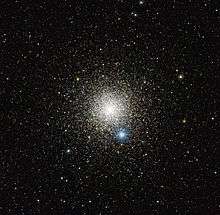NGC 6752
| NGC 6752 | |
|---|---|
|
| |
| Observation data (J2000 epoch) | |
| Class | VI[1] |
| Constellation | Pavo |
| Right ascension | 19h 10m 52.11s[2] |
| Declination | –59° 59′ 04.4″[2] |
| Distance | 13.0 kly (4.0 kpc)[3] |
| Apparent magnitude (V) | 5.4 [4] |
| Apparent dimensions (V) | 20.4′ |
| Physical characteristics | |
| Mass | 1.4×105[5] M☉ |
| VHB | 13.7 |
| Metallicity | = –1.24[6] dex |
| Estimated age | 11.78 Gyr[6] |
| Other designations | Caldwell 93 |
NGC 6752 (also known as Caldwell 93) is a globular cluster in the constellation Pavo.[7] It is the third-brightest in the sky, after Omega Centauri and 47 Tucanae,[8] and is best seen from June to October in the Northern Hemisphere.[9]
NGC 6752 was first identified by one James Dunlop of Parramatta on 30 June 1826, who described it as an irregular bright nebula which could be resolved into a cluster of many stars, highly compressed at the centre. This corresponds with a core region densely populated with stars around 1.3 light-years in diameter, which indicates it has undergone core collapse. The cluster lies around 13,000 light-years distant and is one of the closer globular clusters to Earth. It also lies 17,000 light-years away from the galactic centre.[7] It belongs to Shapley–Sawyer Concentration Class VI, namely of intermediate density,[1] and has been calculated to be 11.78 billion years old.[6] There are a large number of binary stars in the system, as well as blue stragglers, which are likely to have been formed by collisions and mergers of smaller stars. The NASA website "Astronomy Picture of the Day" notes that it holds over 100,000 stars in a sphere about 100 light-years in diameter.[8]
The apparent magnitude of the cluster is 5.4, so it can be seen with the unaided eye.[7] However this depends on good viewing conditions with a minimum of light pollution.[9] With binoculars it can be seen to cover an area three quarters the size of the full moon. It lies 1.5 degrees east of 5th-magnitude Omega Pavonis.[7] The nearest bright star is Peacock, which lies 3.25 degrees north and 9.25 degrees east.[9]
Six X-ray sources have been identified in the cluster's core by the Chandra X-Ray Observatory.[9]
Gallery
 NGC 6752 taken by the Wide Field Imager on the MPG/ESO 2.2-meter telescope.[10]
NGC 6752 taken by the Wide Field Imager on the MPG/ESO 2.2-meter telescope.[10] Map showing location of NGC 6752
Map showing location of NGC 6752
References
- 1 2 Shapley, Harlow; Sawyer, Helen B. (August 1927), "A Classification of Globular Clusters", Harvard College Observatory Bulletin (849): 11–14, Bibcode:1927BHarO.849...11S.
- 1 2 Goldsbury, Ryan; et al. (December 2010), "The ACS Survey of Galactic Globular Clusters. X. New Determinations of Centers for 65 Clusters", The Astronomical Journal, 140 (6): 1830–1837, Bibcode:2010AJ....140.1830G, arXiv:1008.2755
 , doi:10.1088/0004-6256/140/6/1830.
, doi:10.1088/0004-6256/140/6/1830. - ↑ Boyles, J.; et al. (November 2011), "Young Radio Pulsars in Galactic Globular Clusters", The Astrophysical Journal, 742 (1): 51, Bibcode:2011ApJ...742...51B, arXiv:1108.4402
 , doi:10.1088/0004-637X/742/1/51.
, doi:10.1088/0004-637X/742/1/51. - ↑ "SIMBAD Astronomical Database". Results for NGC 6752. Retrieved 2007-04-21.
- ↑ Marks, Michael; Kroupa, Pavel (August 2010), "Initial conditions for globular clusters and assembly of the old globular cluster population of the Milky Way", Monthly Notices of the Royal Astronomical Society, 406 (3): 2000–2012, Bibcode:2010MNRAS.406.2000M, arXiv:1004.2255
 , doi:10.1111/j.1365-2966.2010.16813.x. Mass is from MPD on Table 1.
, doi:10.1111/j.1365-2966.2010.16813.x. Mass is from MPD on Table 1. - 1 2 3 Forbes, Duncan A.; Bridges, Terry (May 2010), "Accreted versus in situ Milky Way globular clusters", Monthly Notices of the Royal Astronomical Society, 404 (3): 1203–1214, Bibcode:2010MNRAS.404.1203F, arXiv:1001.4289
 , doi:10.1111/j.1365-2966.2010.16373.x.
, doi:10.1111/j.1365-2966.2010.16373.x. - 1 2 3 4 O'Meara, Stephen James (2013). Deep-Sky Companions: Southern Gems. Cambridge University Press. pp. 410–12. ISBN 1107015014.
- 1 2 Nemiroff, R.; Bonnell, J., eds. (5 July 2013). "Globular Star Cluster NGC 6752". Astronomy Picture of the Day. NASA. Retrieved 20 August 2013.
- 1 2 3 4 Mobberley, Martin (1999). The Caldwell Objects And How to Observe Them. Springer. pp. 194–95. ISBN 978-1-4419-0326-6.
- ↑ "Low Sodium Diet Key to Old Age for Stars". ESO Press Release. Retrieved 30 May 2013.
External links
- NGC 6752 on WikiSky: DSS2, SDSS, GALEX, IRAS, Hydrogen α, X-Ray, Astrophoto, Sky Map, Articles and images
- http://seds.org/
Coordinates: ![]() 19h 10m 51.8s, −59° 58′ 54.7″
19h 10m 51.8s, −59° 58′ 54.7″
